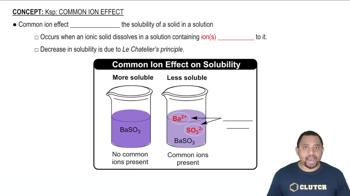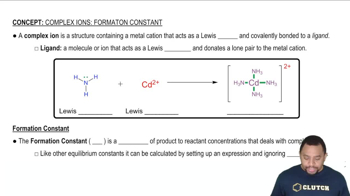Here are the essential concepts you must grasp in order to answer the question correctly.
Solubility Product Constant (Ksp)
The solubility product constant (Ksp) is a numerical value that represents the extent to which a sparingly soluble ionic compound can dissolve in water. It is defined as the product of the molar concentrations of the ions, each raised to the power of their coefficients in the balanced dissolution equation. For Zn(OH)2, the Ksp expression would involve the concentrations of Zn²⁺ and OH⁻ ions, and changes in these concentrations can affect solubility.
Recommended video:
Solubility Product Constant
Common Ion Effect
The common ion effect refers to the decrease in solubility of a salt when a common ion is added to the solution. In the case of Zn(OH)2, if NaCN is added, it introduces CN⁻ ions, which can affect the equilibrium of the dissolution reaction. Understanding this effect is crucial for predicting how the addition of certain ions influences the solubility of sparingly soluble compounds.
Recommended video:
Complex Ion Formation
Complex ion formation occurs when metal ions bind with ligands to form a larger, charged species. In this scenario, the addition of NaCN can lead to the formation of the complex ion [Zn(CN)4]²⁻, which effectively removes Zn²⁺ ions from the solution. This shift in equilibrium can increase the solubility of Zn(OH)2, as the dissolution reaction will shift to produce more Zn²⁺ ions to counteract the decrease caused by complexation.
Recommended video:
Complex Ions and Formation Constant




